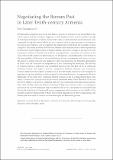Files in this item
Negotiating the Roman past in later tenth-century Armenia
Item metadata
| dc.contributor.author | Greenwood, Timothy William | |
| dc.date.accessioned | 2019-12-03T10:30:02Z | |
| dc.date.available | 2019-12-03T10:30:02Z | |
| dc.date.issued | 2019 | |
| dc.identifier | 260363364 | |
| dc.identifier | 19687115-dc0a-430e-b264-3a64c8d0a52c | |
| dc.identifier.citation | Greenwood , T W 2019 , ' Negotiating the Roman past in later tenth-century Armenia ' , Medieval Worlds. Comparative and Interdisciplinary Studies , vol. 10 , pp. 130-150 . https://doi.org/10.1553/medievalworlds_no10_2019s130 | en |
| dc.identifier.issn | 2412-3196 | |
| dc.identifier.other | ORCID: /0000-0002-2208-0692/work/65702676 | |
| dc.identifier.uri | https://hdl.handle.net/10023/19046 | |
| dc.description.abstract | The Byzantine expansion eastwards into historic regions of Armenia in the second half of the tenth century and the Armenian responses to that expansion both receive modest coverage in Armenian historical narratives. Yet several works of Armenian historical literature were composed during this period which do not comment directly upon present circumstances but which, nevertheless, can be examined for what they reveal about the attitudes of their compilers. This study examines how historic Roman-Armenian encounters were represented in three such works. Despite their proximate dating, they attest a range of perspectives. The anonymous author of the History of Tarōn reimagined the conversion of Armenia at the start of the fourth century by Saint Gregory the Illuminator, highlighting the contribution of the metropolitan of Caesarea in the establishment of sees, monasteries and martyria across the region. A similar process was underway at the time following the Byzantine annexation of Tarōn and the attendant reconfiguration of the ecclesiological landscape. The History of Uxtanēs bishop of Sebasteia was completed between 980 and 989 CE by an Armenian orthodox bishop and projects historic antagonism between Romans and Armenians. Uxtanēs sharpened the negative presentation of several Roman emperors from Antiquity by applying derogatory epithets usually reserved in Armenian literature for oppressive Persian Šahanšahs. At the same time, Armenian leaders were projected as compromising their autonomy. Uxtanēs also incorporated much-altered traditions about Saint Theodore Tiron and the Forty Martyrs of Sebasteia, implying that they were Armenian Christians persecuted for their faith. Finally, while the Universal History of Step‘anos Tarōnec‘i offers an ambiguous portrait of the current Byzantine emperor, Basil II, the writer’s antipathy is revealed through his hostile depiction of Constans II whose engagement with Armenia in the middle of the seventh century prefigured that of Basil II in several respects. In all three compositions, the Roman past was used as a mirror to comment upon the Byzantine present. | |
| dc.format.extent | 21 | |
| dc.format.extent | 209597 | |
| dc.language.iso | eng | |
| dc.relation.ispartof | Medieval Worlds. Comparative and Interdisciplinary Studies | en |
| dc.subject | Armenia | en |
| dc.subject | Basil II | en |
| dc.subject | Byzantium | en |
| dc.subject | Constans II | en |
| dc.subject | Conversion | en |
| dc.subject | Saint Gregory | en |
| dc.subject | Historiography | en |
| dc.subject | Sebasteia | en |
| dc.subject | Saint Theodore | en |
| dc.subject | Tarōn | en |
| dc.subject | BT Doctrinal Theology | en |
| dc.subject | D111 Medieval History | en |
| dc.subject | DE The Mediterranean Region. The Greco-Roman World | en |
| dc.subject | T-NDAS | en |
| dc.subject.lcc | BT | en |
| dc.subject.lcc | D111 | en |
| dc.subject.lcc | DE | en |
| dc.title | Negotiating the Roman past in later tenth-century Armenia | en |
| dc.type | Journal article | en |
| dc.contributor.institution | University of St Andrews. School of History | en |
| dc.contributor.institution | University of St Andrews. Institute of Legal and Constitutional Research | en |
| dc.contributor.institution | University of St Andrews. St Andrews Institute of Medieval Studies | en |
| dc.identifier.doi | 10.1553/medievalworlds_no10_2019s130 | |
| dc.description.status | Peer reviewed | en |
This item appears in the following Collection(s)
Items in the St Andrews Research Repository are protected by copyright, with all rights reserved, unless otherwise indicated.

